The evolution of creative industries
DOI:
https://doi.org/10.21847/1728-9343.2016.1(141).64286Keywords:
creativity, creative industries, creative products, scientific and technological development, communicationAbstract
The article is devoted to the problem of outlining the evolution of creative industries. The meaning of notions "creativity" and "creative industry" is highlighted. Major stages of the origin and development of creative industries, which are pre-industrial age, industrial age and post-industrial age, are identified. The comparative analysis of the evolution of creative industries throughout the centuries is carried out.
References
Albert R. and Runco M. (1999), A History of Research on Creativity, in: Sternberg R. J. Handbook of Creativity, Cambridge University Press, New York, p. 5.
Department for Culture, Media & Sport (1998), Creative Industries Mapping Documents 1998. Communications and telecomms and Media and creative industries, The United Kingdom.
Howkins J. (2001). The creative economy, Penguin, London.
Kaser M. and Knütel R. (2008), Römisches Privatrecht, München.
Knell J. and Oakley K. (2007), London’s Creative Economy: An Accidental Success? (Provocation series, vol. 3, no. 3), The Work Foundation, London, p. 5, available at: http://www.theworkfoundation.com/DownloadPublication/Report/63_63_creative_London.pdf.
O’Connor, J. (2010). The cultural and creative industries: a literature review, 2nd ed., Creativity, Culture and Education Series.
Office for the Arts (1994), Creative nation: Commonwealth cultural policy, Government of Australia.
Downloads
Published
How to Cite
Issue
Section
License
Copyright (c) 2016 Iryna Skavronska

This work is licensed under a Creative Commons Attribution-NonCommercial-NoDerivatives 4.0 International License.
1. Authors bear responsibility for the accuracy of facts, quotations, numbers and names used.
2. Manuscripts are not sent back.
3. The publisher does not always agree with the authors' opinion.
4. The authors reserve the right to authorship of the work and pass the first publication right of this work to the journal under the terms of a Creative Commons Attribution Non-Commercial License, which allows others to freely distribute the published research with the obligatory reference to the authors of the original work and the first publication of the work in this journal.
5. The authors have the right to conclude separate supplement agreements that relate to non-exclusive work distribution in the form in which it has been published by the journal (for example, to upload the work to the online storage of the journal or publish it as part of a monograph), provided that the reference to the first publication of the work in this journal is included.

